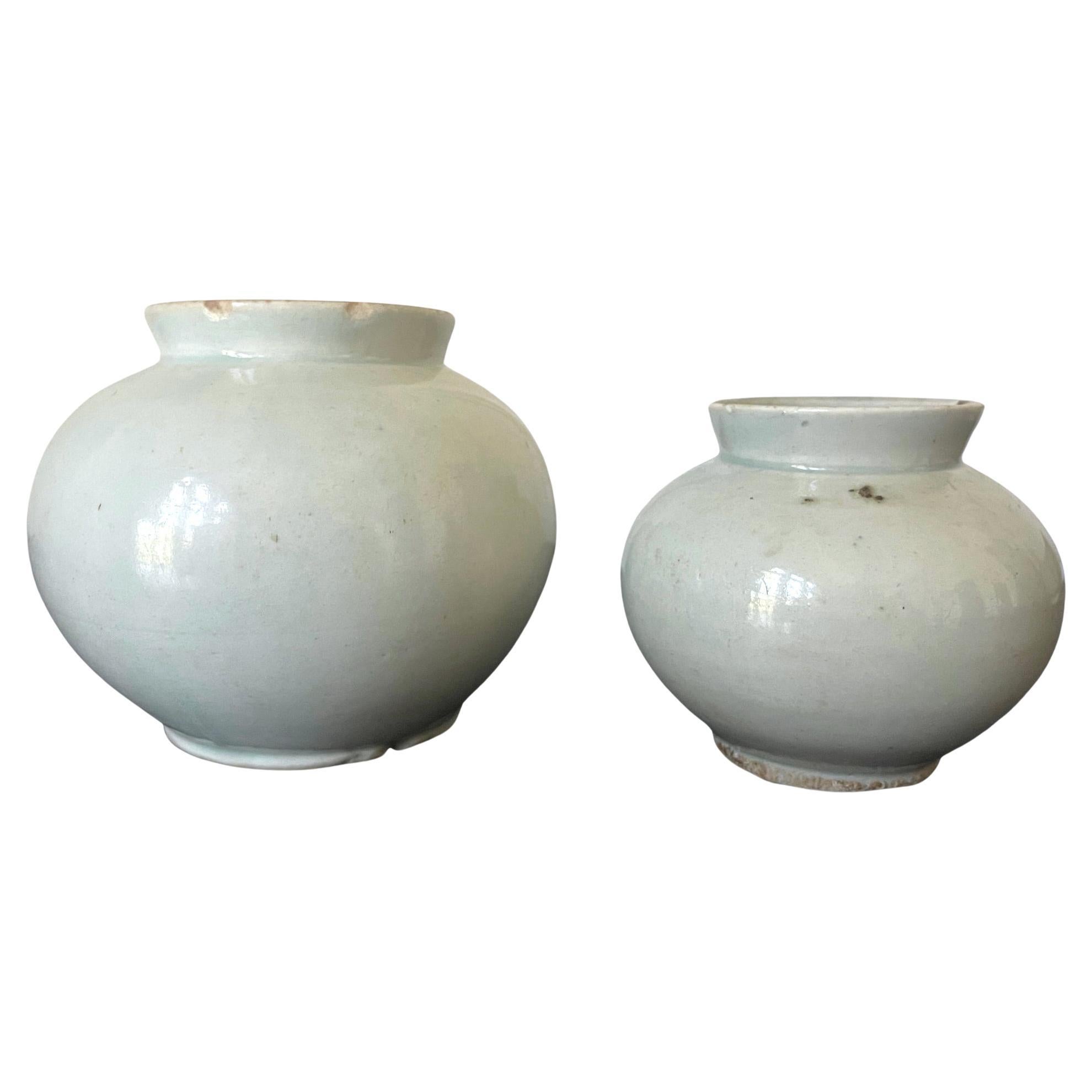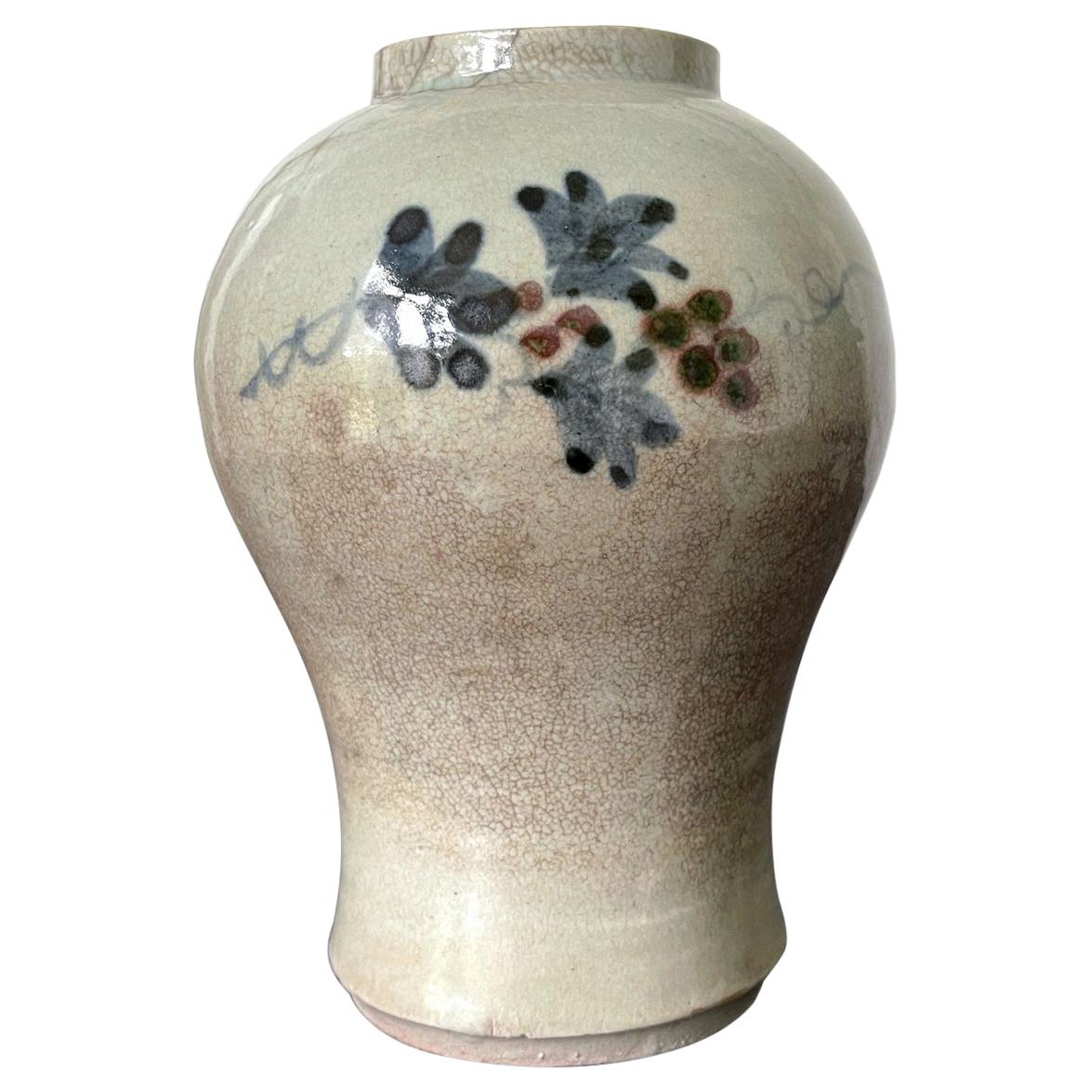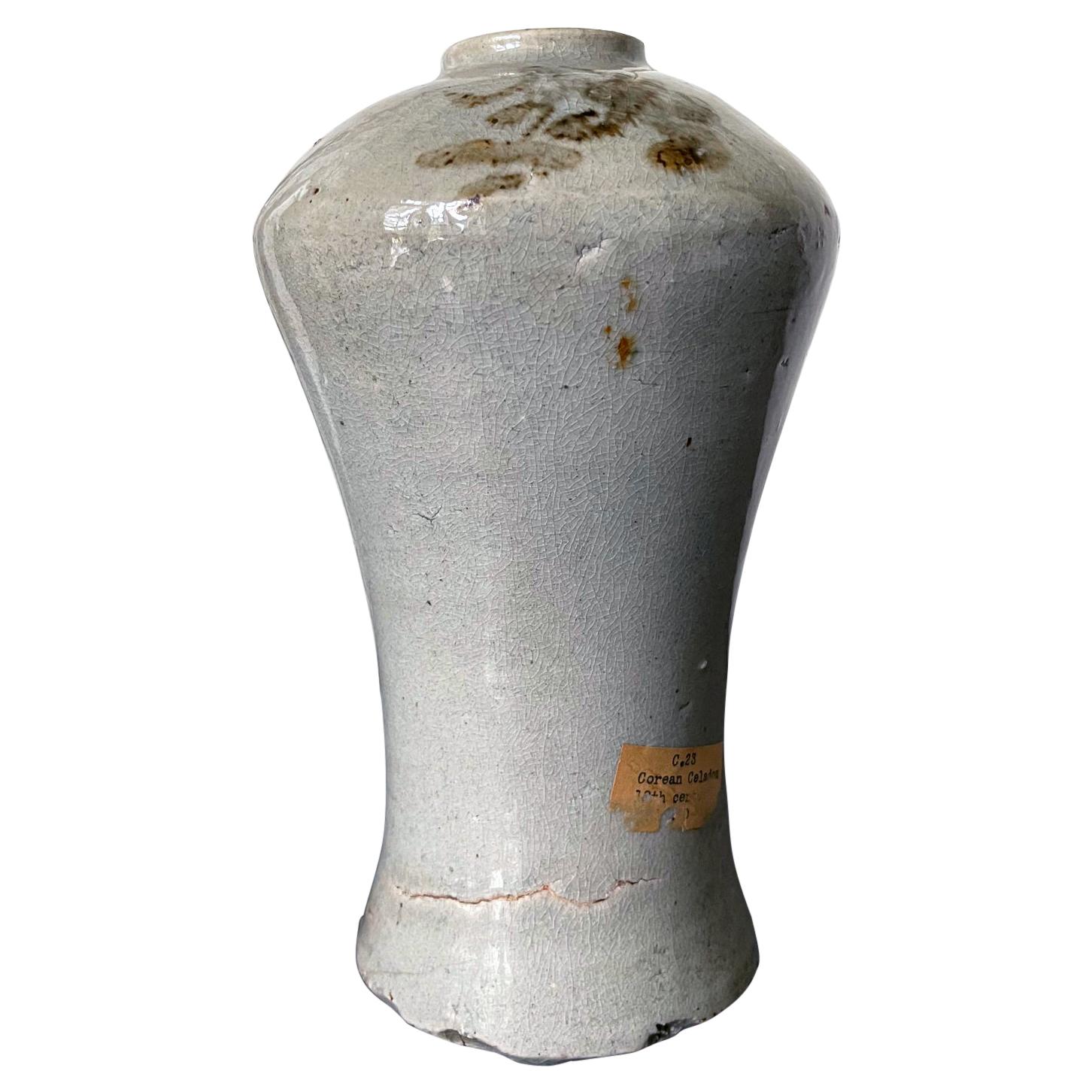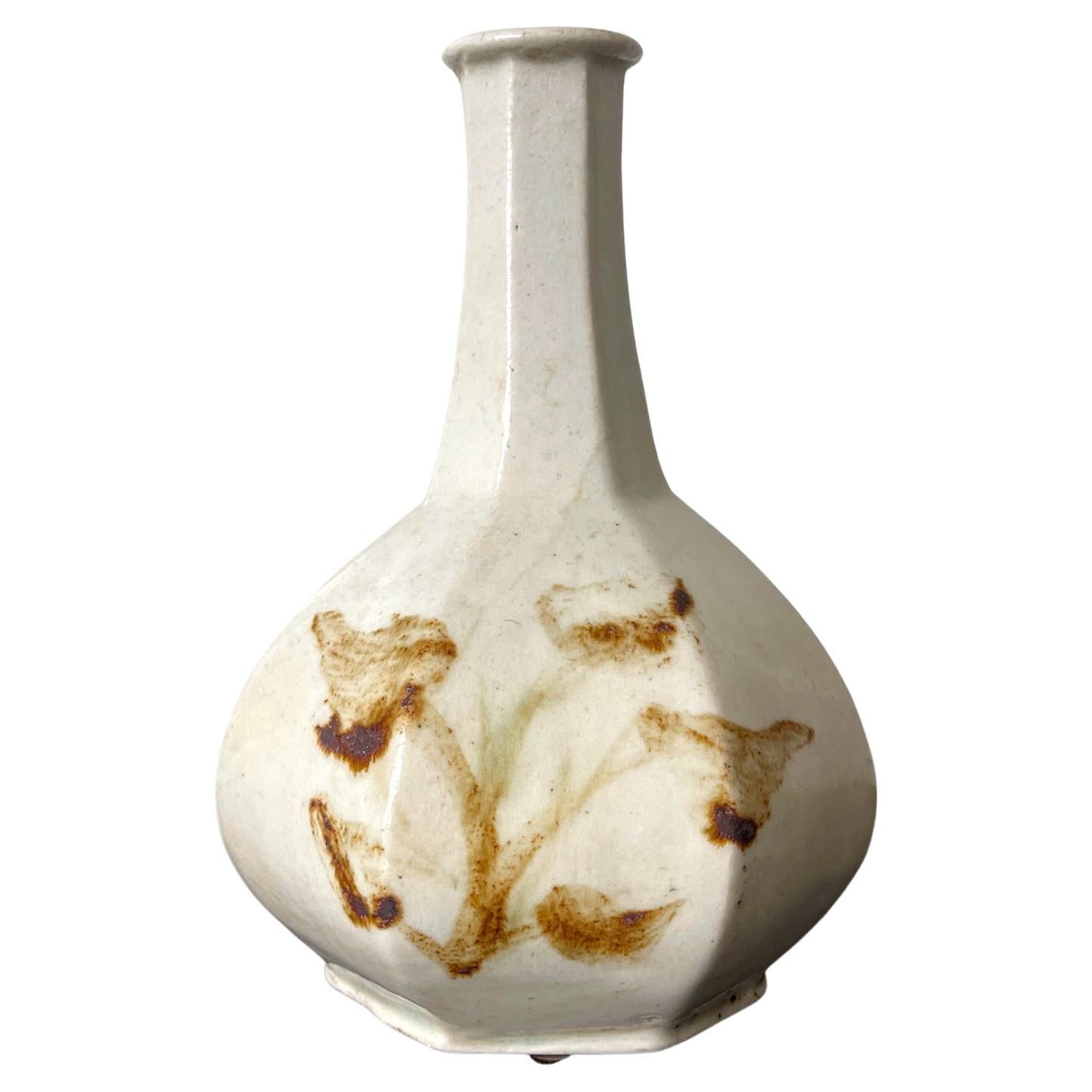Items Similar to Korean Ceramic Moon Jar with Dragon Joseon Dynasty
Want more images or videos?
Request additional images or videos from the seller
1 of 21
Korean Ceramic Moon Jar with Dragon Joseon Dynasty
About the Item
On offer is a large Korean ceramic storage jar (hangari) with white glaze and iron red underglaze dragon design. The globular shaped jar derived its form from the Moon Jar of the early Joseon dynasty, which were fused with two hemispheres and mostly glazed in pure white. This jar was made as a single piece on potter's wheel and was likely dated from 18th century. It was decorated with underglaze iron red painting of a dragon chasing a flaming pearl among the clouds, a beloved motif in Korean art. The rustic rendering of the dragon was rather humorous and full of folky charm. The strokes were dynastic but also naive and child-like. This combined with the bold form of the jar, make the piece quite attractive. By examining the quality of the clay and the glaze, as well as the execution, it appears to us that instead of being produced in the government-run kilns in Gwangju, which was more vigorous in controlling its output, the jar might be made at a private kiln outside the capital area and designated for vernacular use.
It retains a paper sticker of Japanese collection indicating that this jar belonged to the Kishu Tokugawa family, which is a branch of the Tokugawa clan based in Abe, Shizuoka. It was founded in 1619, when Tokugawa Yorinobu, 10th son of Tokugawa Leyasu, was appointed to rule Kii Province. In addition, there is a catalog number and description "Li Dynasty" in Kanji as well as a location name that appears to be "South X Courtyard X".
For a very similar jar see lot 7018 of Bonham's New York Sale "The Korean Aesthetic: The Collection of Robert W. Moore". 03/15/2017
Older jars with similar design can be found in the collection of Philadelphia Musuem of Art (Accession Number: 2002-196-1); National Musuem of Korea (Deoksu 1836); Asian Art Musuem San Francisco (2003.9).
- Dimensions:Height: 10 in (25.4 cm)Diameter: 12 in (30.48 cm)
- Style:Archaistic (Of the Period)
- Materials and Techniques:Ceramic,Glazed
- Place of Origin:
- Period:
- Date of Manufacture:18th Century
- Condition:Wear consistent with age and use. Minor losses. Patina in keeping with the material and age. Long stable crackle line toward the base, small old chips and losses to the base. Some glaze imperfection and scratch lines underneath from the kiln process. Old sticker remains. All as shown.
- Seller Location:Atlanta, GA
- Reference Number:1stDibs: LU945028832362
About the Seller
5.0
Platinum Seller
These expertly vetted sellers are 1stDibs' most experienced sellers and are rated highest by our customers.
Established in 2006
1stDibs seller since 2010
483 sales on 1stDibs
Typical response time: <1 hour
- ShippingRetrieving quote...Ships From: Atlanta, GA
- Return PolicyA return for this item may be initiated within 2 days of delivery.
More From This SellerView All
- Two Korean White Ceramic Jars Joseon DynastyLocated in Atlanta, GATwo ensuite Korean porcelain jars circa early 19th century Joseon Dynasty, attributed to Punwon-ri ware and measures 5.5" diameter x 4" height and...Category
Antique Early 19th Century Korean Archaistic Ceramics
MaterialsCeramic
- Korean Ceramic Storage Jar Joseon DynastyLocated in Atlanta, GAA Korean ceramic storage jar circa 18th century of Joseon Dynasty. The jar is of a characteristic form with a bulbous upper body that tappers with a gra...Category
Antique 18th Century Korean Other Ceramics
MaterialsCeramic
- Tall Korean Ceramic Storage Jar Joseon DynastyLocated in Atlanta, GAA Korean ceramic storage jar circa 18th century of Joseon Dynasty. The jar is of a classic Maebyong form (known in Chinese as Plum Vase or Meiping...Category
Antique 18th Century Korean Other Ceramics
MaterialsCeramic
- Faceted Korean Ceramic Celadon Jar Joseon DynastyLocated in Atlanta, GAA small ceramic celadon storage jar circa 18th century of Korean Joseon Dynasty. The melon shape jar with a mouth and base of the same size display a beautiful harmony in its form. T...Category
Antique 18th Century Korean Other Ceramics
MaterialsCeramic
- Korean Ceramic Faceted Wine Bottle Vase Joseon DynastyLocated in Atlanta, GAA Korean ceramic bottle with octagonal faceted form with underglaze copper red decoration. The robust bottle with the long neck and a relatively thick built was used to hold liquor such as wine and it was from Joseon dynasty, likely late period (circa mid-late 19th century). The bottle was covered in a milky white glaze with a pleasant warm yellow tint. It has an underglaze iron red paint of branches of gingko leaves on the front and the back side. The color was oxidated into an ochre brown hue instead of iron red. The octagonal form extends nicely from the opening to the base, continuing through the body and makes this bottle geometrically interesting. The rustic paint of the gingko leaves also render the piece a folky modern appeal. For three faceted wine bottles from different period of Joseon Dynasty, see illustration 2, 71 and 73 of "Five Centuries of Korean Ceramics Pottery and Porcelains of the Yi Dynasty...Category
Antique 19th Century Korean Archaistic Ceramics
MaterialsCeramic
- Korean Glazed Ceramic Vase Buncheong Ware Early Joseon DynastyLocated in Atlanta, GAAn antique Korean Buncheong stoneware vase from early Joseon Dynasty circa late 15th to early 16th century. The vase is of a classic pear form with a ...Category
Antique 15th Century and Earlier Korean Archaistic Ceramics
MaterialsCeramic
You May Also Like
- Korean White Glazed Jar, Joseon Dynasty, 18th Century, KoreaLocated in Austin, TXA sublime Korean white glazed porcelain globular jar, Joseon Dynasty, 18th century, Korea. The squat jar is heavily potted, with a globular body, very short neck, and wide mouth r...Category
Antique 18th Century Korean Ceramics
MaterialsPorcelain
- Small Korean White Glazed Porcelain Moon Jar, Joseon Dynasty, 18th/19th CenturyLocated in Austin, TXA subtle and sublime small Korean white glazed porcelain moon jar, Joseon Dynasty, 18th/19th century, Korea. The small moon jar of typical form, ...Category
Antique Early 1800s Ceramics
MaterialsPorcelain
- Korean Buncheong Joseon Dynasty Glazed Pottery Ceramic Calligraphy VaseLocated in Studio City, CAA beautifully glazed and colored, hand-decorated Korean Buncheong vase. Joseon Dynasty (1392-1910). Very nice patina. We are listing it as 19th cent...Category
Antique 19th Century Korean Ceramics
MaterialsEarthenware
- Moon Jar / Korean Antique vase / Joseon Dynasty / 18th CenturyLocated in Kyoto-shi, KyotoIt's a wonderful moon jar. It is a rare size that is suitable for the alcove of a Japanese tea room. It is shaped at once without connecting the uppe...Category
Antique 18th Century Korean Antiquities
MaterialsCeramic
- Moon Jar 'Dalhanari', Lot3 / 17th Century / Korean Antiques / Joseon DynastyLocated in Kyoto-shi, KyotoThis is a white porcelain jar from the mid-Joseon period, also known as a "Talhunari" or "moon jar". During the Joseon Dynasty, which was strongly influenced by Confucianism, the purity of white porcelain was particularly prized in its artistic expression due to its Confucian sensitivity. The defining characteristic of white porcelain during this period was its pure white color, but there were many subtle variations in the white hues, with some being classified as milky white, snowy white, ashen white, and bluish white. The term "Talhunari" means "moon jar" in Korean, and it refers to the large, round shape of the jar, resembling a full moon. It was named by Kim Whanki, a representative abstract painter of Korea. The soft, curving lines and sturdy body that seems to embrace the full moon give the jar both power and tranquility. This type of jar was produced in large quantities during the 17th century. The white of the moon jar is not the pure white of early Joseon porcelain...Category
Antique 17th Century Korean Ceramics
MaterialsCeramic, Porcelain
- Moon Jar 'Dalhanari' - Lot2 / 17th Century / Korean Antiques / Joseon DynastyLocated in Kyoto-shi, KyotoThis is a white porcelain jar from the mid-Joseon period, also known as a "Talhunari" or "moon jar". During the Joseon Dynasty, which was strongly influenced by Confucianism, the purity of white porcelain was particularly prized in its artistic expression due to its Confucian sensitivity. The defining characteristic of white porcelain during this period was its pure white color, but there were many subtle variations in the white hues, with some being classified as milky white, snowy white, ashen white, and bluish white. The term "Talhunari" means "moon jar" in Korean, and it refers to the large, round shape of the jar, resembling a full moon. It was named by Kim Whanki, a representative abstract painter of Korea. The soft, curving lines and sturdy body that seems to embrace the full moon give the jar both power and tranquility. This type of jar was produced in large quantities during the 17th century. The white of the moon jar is not the pure white of early Joseon porcelain...Category
Antique 17th Century Korean Antiquities
MaterialsCeramic, Porcelain





